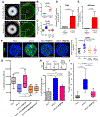Modeling Steatohepatitis in Humans with Pluripotent Stem Cell-Derived Organoids
- PMID: 31155493
- PMCID: PMC6687537
- DOI: 10.1016/j.cmet.2019.05.007
Modeling Steatohepatitis in Humans with Pluripotent Stem Cell-Derived Organoids
Abstract
Human organoid systems recapitulate in vivo organ architecture yet fail to capture complex pathologies such as inflammation and fibrosis. Here, using 11 different healthy and diseased pluripotent stem cell lines, we developed a reproducible method to derive multi-cellular human liver organoids composed of hepatocyte-, stellate-, and Kupffer-like cells that exhibit transcriptomic resemblance to in vivo-derived tissues. Under free fatty acid treatment, organoids, but not reaggregated cocultured spheroids, recapitulated key features of steatohepatitis, including steatosis, inflammation, and fibrosis phenotypes in a successive manner. Interestingly, an organoid-level biophysical readout with atomic force microscopy demonstrated that organoid stiffening reflects the fibrosis severity. Furthermore, organoids from patients with genetic dysfunction of lysosomal acid lipase phenocopied severe steatohepatitis, rescued by FXR agonism-mediated reactive oxygen species suppression. The presented key methodology and preliminary results offer a new approach for studying a personalized basis for inflammation and fibrosis in humans, thus facilitating the discovery of effective treatments.
Keywords: Wolman disease; atomic force microscopy; embryonic stem cell; fibrosis; human liver organoid; induced pluripotent stem cell; inflammation; multicellular tissue; steatohepatitis.
Copyright © 2019 Elsevier Inc. All rights reserved.
Conflict of interest statement
DECLARATION OF INTERESTS
There are no financial interests related to this work.
Figures




Comment in
-
Organoid modelling of NAFLD.Nat Rev Gastroenterol Hepatol. 2019 Aug;16(8):454-455. doi: 10.1038/s41575-019-0181-3. Nat Rev Gastroenterol Hepatol. 2019. PMID: 31267040 No abstract available.
References
-
- Babbs C, Smith A, Hunt LP, Rowan BP, Haboubi NY, and Warnes TW (1988). Type III procollagen peptide: a marker of disease activity and prognosis in primary biliary cirrhosis. Lancet 1, 1021–1024. - PubMed
-
- Begriche K, Igoudjil A, Pessayre D, and Fromenty B (2006). Mitochondrial dysfunction in NASH: causes, consequences and possible means to prevent it. Mitochondrion 6, 1–28. - PubMed
Publication types
MeSH terms
Grants and funding
LinkOut - more resources
Full Text Sources
Other Literature Sources
Molecular Biology Databases
Research Materials

